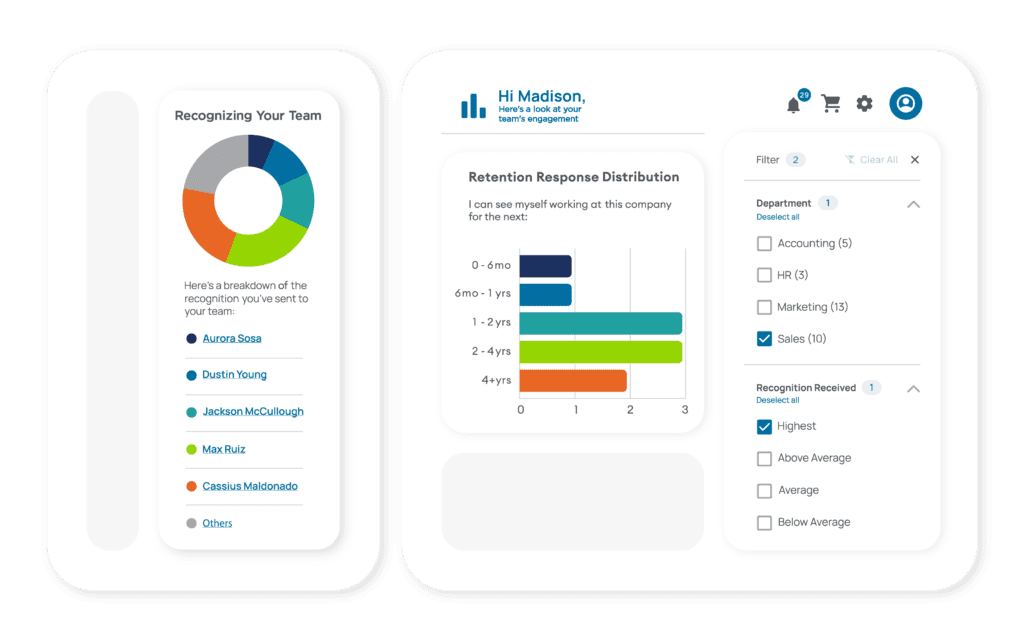October 20, 2025

Curious about how leading companies engage their employees? This article highlights the top examples of employee engagement in companies, including the best employee engagement initiatives and strategies used to boost involvement, enthusiasm, and satisfaction.
Key Takeaways
- Employee engagement drives employee productivity, commitment, and innovation, leading to higher profitability and lower turnover rates.
- Companies like Google and Salesforce leverage employee engagement programs, wellness initiatives, and technology-driven strategies to enhance employee satisfaction and engagement.
- Tracking engagement metrics through surveys and analytics tools helps organizations monitor and improve employee engagement levels.
- Fostering a culture of recognition, open communication, and inclusivity is essential for creating a motivated workforce that drives the company's success.
What is Employee Engagement?

Employee engagement refers to the level of enthusiasm, connectedness, and happiness employees feel towards their job. It’s more than just job satisfaction; it’s about the emotional and mental connection employees have with their organization, team, and work. Engaged employees are those who are enthusiastic about their roles, committed to their organization’s goals, and motivated to contribute to its success.
The key elements of employee engagement include emotional commitment, employee motivation, productivity, and employee autonomy, which empowers individuals with independence in decision-making and problem-solving.
An effective employee engagement strategy is a comprehensive approach that incorporates technology, company values, and wellness programs to strengthen the connection between employees and the organization. When employees are engaged, they are more likely to be productive, showcase greater commitment to their work, and contribute innovative ideas.
High levels of employee engagement indicate that employees feel valued and connected to their roles and the organization. This fosters loyalty, reduces absenteeism, and lowers talent acquisition costs. Employee development and career development are also crucial factors that foster engagement by providing growth opportunities and supporting long-term progression within the organization.
Employee engagement is a two-way street, reflecting a commitment and communication between team members and the firm. It involves regular employee recognition and appreciation of employees, which is essential for fostering an emotional connection.
Employee engagement initiatives aim to foster a positive workplace culture. In this environment, employees feel valued, heard, and invested in their work, promoting employee participation. Employee engagement is important for the overall success of the organization.
Why Employee Engagement Matters

Highly engaged employees are the lifeblood of a successful organization. They're generally more productive and positively influence company culture. Studies have shown that organizations with higher employee engagement experience a marked increase in overall productivity, with some suggesting up to a 21% rise. This boost in productivity directly ties to individual and organizational success, keeping employees engaged.
Prioritizing employee engagement as a core strategy is essential for long-term organizational success and growth. When employees feel valued and heard, they are more likely to go above and beyond in their roles, leading to positive business outcomes.
Cultivating a culture of employee engagement is essential for organizational success. It fosters happier, more motivated employees who are less likely to leave the organization. Strong employee relationships, built through team-building activities and collaboration, further contribute to higher engagement levels. So much so, research suggests that companies with highly engaged employees can see:
- A 23% increase in profitability
- A 51% drop in turnover
- Lower absenteeism rates
Successful employee engagement initiatives foster a culture of appreciation. In such an environment, employees feel valued, heard, and invested in their work. It's important to reward employees for their contributions, as this not only boosts employee morale but also enhances overall employee well-being, making it a critical component of any organization’s strategy for success.
Employee Resource Groups: Building Community and Support
Employee Resource Groups (ERGs) are a cornerstone of effective employee engagement strategies, helping to create a positive workplace culture where every team member feels valued and supported.
ERGs are voluntary, employee-led groups that bring together individuals with shared interests, backgrounds, or goals—such as diversity and inclusion, mental health support, or professional development opportunities. By establishing employee resource groups, companies can foster a sense of belonging and community, which is essential for keeping employees engaged and motivated.
ERGs also provide a valuable channel for employee feedback, allowing organizations to better understand and address the needs of their workforce. This, in turn, helps boost employee engagement, improve employee retention, and support overall employee satisfaction.
8 Companies That Excel at Employee Engagement
Employee engagement isn’t just about perks or paychecks—it’s about creating a workplace where people feel valued, supported, and inspired. Some top employee engagement companies have mastered this better than others.
Let’s take a look at how eight industry leaders are keeping their employees happy, motivated, and thriving.
1. Google: Prioritizing Employee Well-Being
Google has long been known for setting the standard in employee engagement—and its wellness programs are a big reason why. From on-site fitness centers to healthy meals and mental health resources, Google takes a holistic approach to well-being.
To facilitate feedback and track engagement, Google uses employee engagement software that enables real-time communication, recognition, and data-driven insights. The company also leverages engagement metrics to assess the effectiveness of its programs and make informed decisions to further support employee well-being.
These initiatives not only improve health and reduce medical costs but also help employees feel cared for and supported. When people feel their employer invests in their well-being, engagement naturally follows.
Google also emphasizes professional development, offering countless opportunities for learning and career growth. By combining wellness and growth, Google creates a culture where employees feel their best—personally and professionally.
2. Salesforce: Using Technology to Drive Engagement
Salesforce doesn’t just build tech for customers—it uses it to strengthen its own workplace culture. The company leverages data and analytics to understand employee sentiment, track engagement trends, and tailor programs that meet real needs.
Salesforce also invests in training programs to support employee growth, foster engagement, and promote diversity and professional development.
Its integrated engagement platforms connect everything from performance management to learning and recognition. The result? A workplace where employees feel seen, supported, and empowered. Salesforce proves that when technology and empathy intersect, engagement flourishes.
3. Adobe: Fostering Creativity and Innovation
Adobe knows that creativity thrives when employees feel free to share ideas. The company actively encourages collaboration and innovation across every level of the organization, and fosters employee autonomy by empowering individuals to make decisions, solve problems, and shape their roles within a flexible work environment.
For more than two decades, Adobe has earned a spot on Fortune’s Best Workplaces list—and it’s easy to see why. Employees are given space to explore new ideas, take risks, and grow professionally, with a strong focus on employee development.
By celebrating individuality and innovation, Adobe builds engagement through inspiration and trust.
4. Microsoft: Empowering Growth and Collaboration
At Microsoft, engagement starts with growth. Employees are encouraged to chart personalized career paths and have regular check-ins to discuss progress and goals. This hands-on support helps people feel valued and motivated.
Beyond individual growth, Microsoft also focuses on collaboration. The company organizes team building events such as retreats and group challenges to strengthen collaboration and engagement among employees. Team-building activities, mentorship programs, and learning opportunities bring employees together and strengthen company culture.
5. Zappos: Making Happiness a Business Strategy
Zappos has built its reputation on one powerful belief: happy employees create happy customers. Its culture is famously vibrant and people-focused, with happiness baked into every part of the employee experience.
A standout example is the “Zollars” program—an internal rewards system used to reward employees for living company values. Combined with cultural onboarding and open communication, Zappos ensures every team member feels at home from day one.
6. Spotify: Creating Belonging Through Inclusivity
Spotify’s approach to engagement centers around belonging. The company works to establish employee resource groups (ERGs) as part of its inclusivity efforts, promoting inclusivity and creativity through ERGs that give employees space to connect and share experiences.
Its DEIB (Diversity, Equity, Inclusion, and Belonging) initiatives are more than policies—they’re part of everyday life. By empowering employees to bring their authentic selves to work, Spotify creates a culture where creativity thrives.
When people feel like they belong, they bring their best ideas forward.
7. Netflix: Inspiring Autonomy and Accountability
Netflix believes great work happens when people are trusted to do it. The company’s culture is built on autonomy, accountability, and transparency. Employees are encouraged to make decisions, take initiative, and own their results.
This freedom fosters innovation and high performance. Netflix employees don’t just follow rules—they help write them. By balancing freedom with responsibility, Netflix keeps employees engaged, empowered, and inspired to do their best work.
8. Patagonia: Connecting Purpose and People
Patagonia proves that engagement grows when employees believe in what their company stands for. The outdoor brand’s culture is deeply rooted in sustainability, social responsibility, and a strong commitment to corporate social responsibility (CSR) as a driver of employee engagement.
Through programs like Worn Wear, which promotes repair and reuse, and Patagonia Action Works, which connects people to environmental causes, the company empowers employees to live its mission every day.
That sense of shared purpose fuels pride, loyalty, and engagement—showing that doing good for the planet can also mean doing good for your people.
Tips for Improving Employee Engagement

Improving employee engagement is essential for creating a thriving workplace culture. One effective strategy is utilizing employee recognition programs to celebrate employees who exemplify core values, fostering a culture of appreciation.
1. Recognize and Celebrate Achievements
Regularly acknowledge employee contributions and accomplishments —both big and small. Recognition can come in many forms, from a quick thank-you in a team meeting to a formal rewards program. Genuine appreciation builds morale and strengthens loyalty.
2. Foster Open Communication
Create spaces where employees feel comfortable sharing feedback, ideas, and concerns. Encourage two-way conversations between leadership and staff to build trust and transparency.
3. Offer Opportunities for Growth
Employees are more engaged when they can see a clear path for development. Offer training programs, professional development opportunities, or educational reimbursements to help them achieve personal growth and reach their professional goals.
4. Prioritize Work-Life Balance
Support flexible work options, encourage time off, and model healthy boundaries. A balanced workforce is a happier, more productive one. Offering unlimited vacation days and flexible work arrangements contributes to a positive work-life balance, enhancing overall employee well-being and supporting employee health.
5. Promote Wellness and Mental Health
Introduce wellness programs that support physical and emotional health—such as mindfulness sessions, fitness challenges, or access to counseling. When employees feel cared for, engagement naturally follows.
6. Strengthen Connection to Company Values
Help employees see how their work contributes to the organization’s mission. Reinforce values through recognition, storytelling, and consistent communication from leadership.
7. Encourage Collaboration and Inclusion
Team-based projects and cross-departmental initiatives can help employees feel connected. Make sure every voice is heard and valued, fostering a sense of belonging.
8. Leverage Technology for Engagement
Use digital tools or employee engagement platforms to streamline communication, collect feedback, and celebrate milestones—keeping everyone informed and connected.
9. Empower Employees to Make an Impact
Give employees autonomy in their roles and encourage them to take ownership of projects. Empowerment builds confidence and deepens engagement.
10. Continuously Gather Feedback
Conduct regular pulse surveys or one-on-one check-ins to understand how employees feel and broader employee needs. Use that feedback to make meaningful improvements to culture, communication, and benefits.
How Companies Measure Employee Engagement
Measuring employee engagement is crucial for understanding and improving it. One common method is conducting regular employee engagement surveys, which allow staff to express their concerns and suggestions. These surveys often cover areas such as work-life balance, job roles, and alignment with company values to assess engagement, including employee engagement survey questions.
Employee satisfaction surveys are another valuable tool for gauging employee sentiment. Organizations may employ 360-degree feedback mechanisms to gather comprehensive insights about employee engagement and employee feedback from multiple perspectives, including peers and managers. This holistic approach ensures that the feedback is well-rounded and actionable.
Tracking engagement metrics is essential for monitoring progress and informing data-driven decisions. Employee engagement software plays a key role in collecting and analyzing engagement data, making it easier to identify trends and areas for improvement.
Terryberry’s all-in-one Employee Engagement Platform makes this process effortless by combining recognition, surveys, feedback, and analytics in one intuitive system.
Companies can easily measure engagement levels, uncover what motivates employees, and take meaningful action based on real-time insights. With tools for employee wellness, recognition programs, and engagement surveys, Terryberry helps organizations build a connected culture that inspires employees to do their best work.
Through surveys and feedback mechanisms, organizations can identify disengaged employees and take steps to re-engage them. By continuously measuring employee engagement, companies can create a positive workplace culture that fosters loyalty, productivity, and success.

